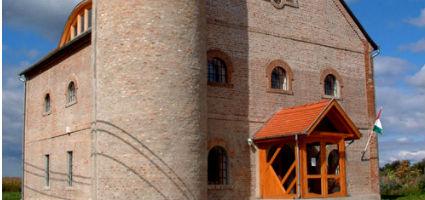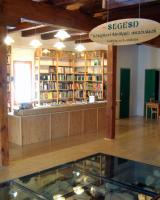2024. July 27. Saturday
Saint Margaret of the Árpád House Museum and Village Library - Segesd
 |
Address: 7562, Segesd Kossuth u. 113/B
Phone number: (82) 733-403
E-mail: muzeum@segesd.hu
Opening hours: Mon-Fri 10-16
|
Segesd and its suburbs have been a densely populated place ever since prehistoric times. During the Roman dominion and after the Original Settlement, it was a place where important roads crossed. The chief and tribe leader settled near Segesd in the first half of the 10th century. After the Hungarian constitution, Segesd belonged to the Episcopate of Veszprém. Overseers of the king and later the queen lived in the centre. The royal 'Comitatus of Segesd' of King Béla IV was first mentioned in a charter from 1245, or rather the land of the overseer and his name Mihály, the son of Jákó. We concluded from the information that kings and queens often strayed in Segesd that served as a court for some time.
A private farm of the king and queen was fortified by an earth fort called the 'predialis' operated in Segesd in the 11-13th century. The court was probably located in the centre surrounded by farm buildings, a garden and of servant homes. We are well aware of estates, the organization of the court and the chain of serving habitats belonging to the king and queen. In consequence of the Tartar invasion, Segesd and habitats belonging to it have been depopulated. To repopulate the, people arrived from European countries.
Segesd was a "civitas" with its "curia and castellum" until the 15th century. During the 15-17th century it was a county town, an "oppidum". A number of villages and habitats belonged to it: The Royal Chapel, the Vicarage in the 11-15th century eg, the earliest Franciscan monastery in Somogy County, a convent established at the end of the 13th century. Kings and Queens gave their estates around Segesd completely away to the Marczali and the Báthory family. From 1566 for the next 130 years the Turkish rules this area. The 14-17th century castle now shows Balkan characteristics.
IV. During the reign of Béla, Segesd played a very important role. After the lost battle at Muhi, the king organized the defence of the country from there. After the Tartar left the country, he directed the rebuilding of the country from Segesd. Then, the centre of the country was Segesd. In 1330 it was mentioned as a "civitas, with its suburbs. In 1389, however, it was called a "oppidum regale", a royal county town. It remained a county town until 1393 when Segesd was given as pledge by the king Zsigmond to several lords. This state lasted until 1417 when the king gave the estate to the Marczali family for good. While the town belonged to the king or queen, it had a special legal statues. The so-called "hospes" and varied people had the right to operate a self-government and committee. According to jurisdiction, they belonged to the king and queen. The vicarage belonged to the bishop of Esztergom.
From the beginning of the 15th century, Segesd was owned by the Marczali and Báthory families with many artisans among the citizens. Mansions on the market square were first mentioned in the 14th century. The town of Segesd was probably located inside a fortification even in the Árpád age and late middle ages. From 1566 to the end of the Turkish era, it was a town with characteristic Balkan atmosphere. Around 1664-1666, Segesd was the local authority of the Pasha of Kanizsa. Around 300 Hungarian serfs leaved int he habitat that had pleasant air, had a water supply and was surrounded by gardens. Two years after the Turkish left, in 1690, it said under the castle: "along with its church surrounded by a wall."
Opposed to the castle, the remains of the town could be spotted even in the 1980's. Remains of private cemeteries of the Pékó, Balogh, Baracsi families could be found in private gardens. During 1981-1989 we performed excavation to unearth these. We unearthed the whole structure of the town that once stood there from the Árpád age. The most important part of this was the market place, the parish and the cemetery around it.
A private farm of the king and queen was fortified by an earth fort called the 'predialis' operated in Segesd in the 11-13th century. The court was probably located in the centre surrounded by farm buildings, a garden and of servant homes. We are well aware of estates, the organization of the court and the chain of serving habitats belonging to the king and queen. In consequence of the Tartar invasion, Segesd and habitats belonging to it have been depopulated. To repopulate the, people arrived from European countries.
Segesd was a "civitas" with its "curia and castellum" until the 15th century. During the 15-17th century it was a county town, an "oppidum". A number of villages and habitats belonged to it: The Royal Chapel, the Vicarage in the 11-15th century eg, the earliest Franciscan monastery in Somogy County, a convent established at the end of the 13th century. Kings and Queens gave their estates around Segesd completely away to the Marczali and the Báthory family. From 1566 for the next 130 years the Turkish rules this area. The 14-17th century castle now shows Balkan characteristics.
IV. During the reign of Béla, Segesd played a very important role. After the lost battle at Muhi, the king organized the defence of the country from there. After the Tartar left the country, he directed the rebuilding of the country from Segesd. Then, the centre of the country was Segesd. In 1330 it was mentioned as a "civitas, with its suburbs. In 1389, however, it was called a "oppidum regale", a royal county town. It remained a county town until 1393 when Segesd was given as pledge by the king Zsigmond to several lords. This state lasted until 1417 when the king gave the estate to the Marczali family for good. While the town belonged to the king or queen, it had a special legal statues. The so-called "hospes" and varied people had the right to operate a self-government and committee. According to jurisdiction, they belonged to the king and queen. The vicarage belonged to the bishop of Esztergom.
From the beginning of the 15th century, Segesd was owned by the Marczali and Báthory families with many artisans among the citizens. Mansions on the market square were first mentioned in the 14th century. The town of Segesd was probably located inside a fortification even in the Árpád age and late middle ages. From 1566 to the end of the Turkish era, it was a town with characteristic Balkan atmosphere. Around 1664-1666, Segesd was the local authority of the Pasha of Kanizsa. Around 300 Hungarian serfs leaved int he habitat that had pleasant air, had a water supply and was surrounded by gardens. Two years after the Turkish left, in 1690, it said under the castle: "along with its church surrounded by a wall."
Opposed to the castle, the remains of the town could be spotted even in the 1980's. Remains of private cemeteries of the Pékó, Balogh, Baracsi families could be found in private gardens. During 1981-1989 we performed excavation to unearth these. We unearthed the whole structure of the town that once stood there from the Árpád age. The most important part of this was the market place, the parish and the cemetery around it.
|
Programmes
|
|
